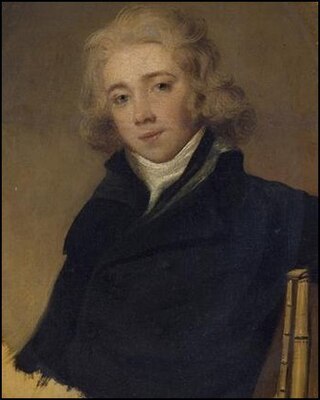In music, perpetuum mobile, moto perpetuo (Italian), mouvement perpétuel (French), movimento perpétuo (Portuguese) movimiento perpetuo (Spanish), carries two distinct meanings: first, as describing entire musical compositions or passages within them that are characterised by a continuous stream of notes, usually but not always at a rapid tempo; and also as describing entire compositions, or extended passages within them that are meant to be played in a repetitious fashion, often an indefinite number of times.
The Young Person's Guide to the Orchestra, Op. 34, is a 1945 musical composition by Benjamin Britten with a subtitle Variations and Fugue on a Theme of Purcell. It was based on the second movement, "Rondeau", of the Abdelazer suite. It was originally commissioned for the British educational documentary film called Instruments of the Orchestra released on 29 November 1946, directed by Muir Mathieson and featuring the London Symphony Orchestra conducted by Malcolm Sargent; Sargent also conducted the concert première on 15 October 1946 with the Liverpool Philharmonic in the Philharmonic Hall, Liverpool, England.
Songs Without Words is a series of short lyrical piano works by the Romantic composer Felix Mendelssohn written between 1829 and 1845. His sister, Fanny Mendelssohn, and other composers also wrote pieces in the same genre.

The String Quartet No. 3 in E♭ minor, Op. 30, by Pyotr Ilyich Tchaikovsky, was composed in 1876, and is the last of his three string quartets. It was written as a memorial for Ferdinand Laub.

Hyacinthe Jadin was a French composer who came from a musical family. His uncle Georges Jadin was a composer in Versailles and Paris, along with his father Jean Jadin, who had played bassoon for the French Royal Orchestra. He was one of five musical brothers, the best known of whom was Louis-Emmanuel Jadin.

Franz Ries was a Romantic German violinist and composer, son of Hubert Ries. He studied at the Paris Conservatory. He also worked in the publishing business.
The Capriol Suite is a set of dances composed in October 1926 by Peter Warlock and is considered one of his most popular works. Originally written for piano duet, Warlock later scored it for both string and full orchestras. According to the composer, it was based on tunes in Thoinot Arbeau's Orchésographie, a manual of Renaissance dances. Nevertheless, Warlock's biographer, Cecil Gray, wrote that "if one compares these tunes with what the composer has made of them it will be seen that to all intents and purposes it can be regarded as an original work".
An organ concerto is an orchestral piece of music in which a pipe organ soloist is accompanied by an an orchestra, although some works exist with the name "concerto" which are for organ alone.
Anna Karenina is a ballet choreographed by Boris Eifman, based on the 1877 novel Anna Karenina by Leo Tolstoy. The première took place in Saint Petersburg on Saturday, 2 April 2005. The music is by Pyotr Ilyich Tchaikovsky and includes excerpts from:
Ruralia hungarica is a name given by the Hungarian composer Ernő Dohnányi to four interrelated works.
Benjamin Britten's Piano Concerto, Op. 13, is the composer's sole piano concerto.
The Cello Sonata, Op. 65, is a work by the English composer Benjamin Britten. It was premiered in July 1961 at the Aldeburgh Festival in Suffolk. The work is in five movements:
- Dialogo. Allegro
- Scherzo-Pizzicato. Allegretto
- Elegia. Lento
- Marcia. Energico
- Moto perpetuo. Presto

The Hungarian composer György Ligeti published three string quartets: two string quartets proper and a student piece from 1950 published toward the end of his life. The first two quartets represent his early period, inspired by Béla Bartók, and middle period, which was largely micropolyphonic.




